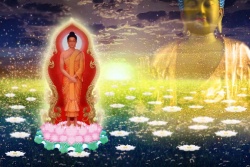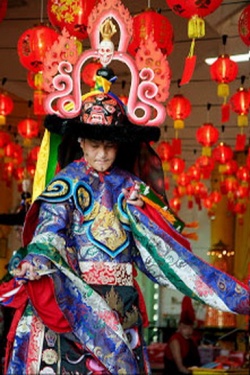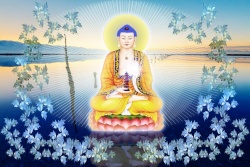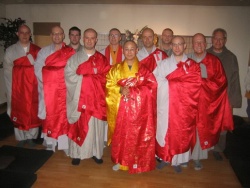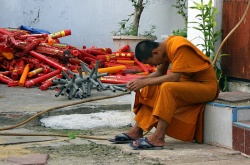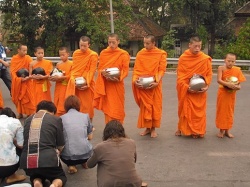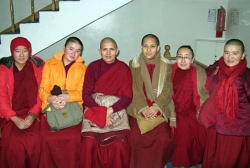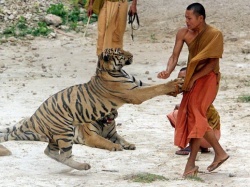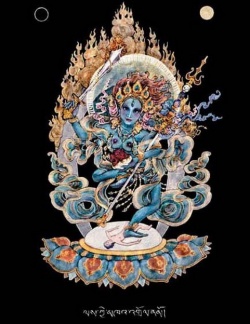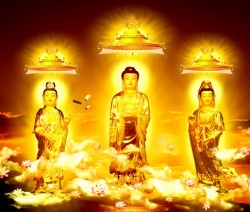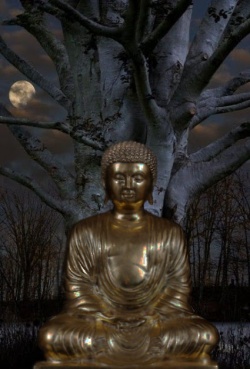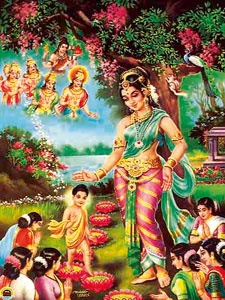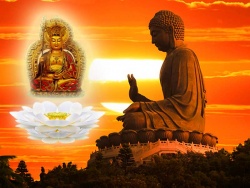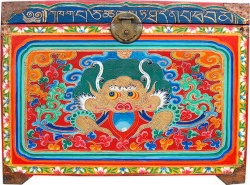Buddhists: Beneficiaries of Violence
Buddhists: Beneficiaries of Violence
By Indrajala (Jeffrey Kotyk)
In 644 Xuanzang 玄奘 (602–664) was staying in the Central Asian kingdom of Khotan, having returned from his long journey to India. He wrote a letter there to the Emperor Taizong seeking permission to return to China. Taizong was apparently quite pleased, though Xuanzang had initially left the empire without official permission. A few months later on the first lunar month of 645, he arrived in the Tang capital Chang'an. A few weeks later he had an audience with Taizong in Luoyang.
There was actually a significant reason why Taizong was then staying in Luoyang and not Chang'an. He was gathering his troops at Luoyang to invade the kingdom of Koguryo (in modern Korea).
The preceding Sui Dynasty (581-618) had attempted to capture Koguryo in several failed expeditions between 598-614, resulting in great loss of life and state revenues, all of which contributed to the premature downfall of said dynasty. In 622 the recently founded Tang Dynasty (618-907) under Emperor Gaozu 高祖 (566-635) had made attempts at reconciliation with Koguryo, agreeing to prisoner exchanges.[1]
Nevertheless, in the same decade Koguryo built massive fortifications along the Liao River in preparation for renewed hostilities. The Korean peninsula continued to suffer war as Koguryo fought with Silla to the south. In China Taizong (598-649) in 626 had killed his two brothers and forced Gaozu to abdicate the throne.
Being a military man and ambitious leader, the Sui failure to capture and subjugate Koguryo became an obsessive concern for Taizong. In 641 he even speculated in court that a renewed assault by land and sea could prove feasible. Intelligence operations commenced around the same time as he dispatched his men to scout the border on reconnaissance missions.
The following year there was a coup d'état in Koguryo by the military leader Yeon Gaesomun who had been in charge of building the Liao River fortifications. Having killed the earlier king Yeongnyu 榮留王, who had nominally been a vassal of the Tang, along with over a hundred aristocrats at court, he was able to place a puppet king Bojang 寶臧王 (r. 642-668) on the throne. The new court proceeded with its policies of greater independence from the Tang court.
Taizong did not immediately act as the northeast plains were still recovering economically from the earlier wars. However, by late 643 Silla, a vassal state of the Tang, had been attacked by Koguryo in alliance with Paekche, thereby preventing tribute missions to the Tang court. Taizong failed to resolve this through diplomatic measures and thereafter decided to personally lead the assault on Koguryo.
His ministers had warned him against initiating such a campaign and no doubt the populace still had living memories of the previous failed campaigns of earlier generations. In 644 Taizong moved himself in the direction of the front and while staying in Luoyang received a letter from a curious Chinese monk on the western frontier requesting permission to return home.
This was around the same time he issued edicts to the empire declaring his reasons for the campaign: Yeon Gaesomun was a tyrant guilty of regicide. This seems to have been propaganda aimed at fostering support because even before the regicide he had already taken the initial steps at surveying the frontier, planning for a future assault. Having a unified Korean peninsula was a threat and moreover he had his own dynastic ambitions to retake the territories which had once been controlled by the Han Dynasty (206 BCE - 220 CE).[2]
Having a Chinese Buddhist monk with loads of scriptures from India arrive just as the preparations were underway for the invasion no doubt would have been an opportune chance at bolstering his imperial image in the face of widespread reluctance to fight another war against Koguryo. It was a quite fortuitous opportunity to elevate his status as benefactor of the sangha while he marched many men to their inevitable deaths. Tansen Sen explains:
- The return of Xuanzang seems to have been taken as an auspicious sign by the emperor. Hence, Taizong, who was generally unsympathetic and sometimes critical of the Buddhist cause, quickly granted audience to Xuanzang. Taizong's aim was not to learn about Buddhist teachings from Xuanzang, nor perhaps was he terribly interested in the details of the Western Regions at that moment, although he did ask the pilgrim to write an account of his journey. More likely, as can be seen from Taizong's suggestion for Xuanzang to return to secular life and assist him in administrative affairs, the emperor wanted to secure spiritual support for his temporal quest. In fact, Taizong indirectly made such a request to the monk: "We cannot completely express our ideas in such a hurry. We wish that you could come with us to the eastern region and observe the local customs. We can carry on the conversation besides directing the army.”[3]
The support for Xuanzang's translation project, and lack of punishment for having exited the country without permission almost two decades prior, might very well have been not so forthcoming had the circumstances been different. Xuanzang obtained the resources and people he needed to work on his translations, but this success of his was perhaps actually tied to the war on the Korean peninsula.
If Taizong had not been readying himself to fight an unpopular aggressive war (it was not defensive in contrast to the struggles with the Turks and Tibetans), we might imagine there would have been a less supportive response from the emperor and Xuanzang's influential translations and new terminology might not have been possible. In other words, Xuanzang was an indirect beneficiary of the war.
This is a theme we see throughout Buddhist history: Buddhists as beneficiaries of violence. In recent years there has been increasing academic interest in examining the topic. Buddhism and Social Justice at Leiden University is one example of a scholarly project aimed at “moving away from a common perception of Buddhism as intrinsically a tradition of peace and justice.” This indeed is at odds with the mainstream western perception of Buddhism. In the west Buddhism is readily associated with liberal western values and pacifism, though the historical realities of Buddhist institutions across Asia would reveal a different image.
In my readings of Buddhist literature and history I have often found that while Buddhists have been reluctant to exercise violence themselves, they often do not object to being either direct or indirect beneficiaries of violence. What this means is that Buddhist institutions might condemn violence and encourage non-violence while benefiting immensely as a client of a greater power which readily employs violence to secure unearned wealth or even just to protect the realm. As we can see with Xuanzang and Taizong, this sort of relationship between the sangha and state could entail quite significant developments. Of course it was not the first time in China. Tansen Sen explains:
- In the past, a number of Buddhist monks, especially those from South and Central Asia, had participated in Chinese military campaigns. The success of their magical and miraculous powers in such operations was legendary since at least the fourth century. The Kuchean monk Fotudeng (an alternate reading of the name is Futucheng), who arrived in China in 310, is perhaps the best example of such “state-monks”. In the fifth century, renowned monk translators such as Jiumoluoshi (Kumārajīva, 344-413) and Tanwuchan (Dharmakṣema?, 385-433) are also known to have assisted the Chinese rulers in military and state affairs. It is not surprising, therefore, that Taizong sought Xuanzang's assistance in the offensive against the Korean kingdom.[4]
We can actually see this same theme play out back in even the earliest time of institutionalized Buddhism. Long ago there was the famous emperor Aśoka (304-232 BCE) who launched a ghoulish war against his enemies. They were largely conquered and subjugated.
Everyone involved in Buddhism at some point hears about his personal crisis where seeing the devastation and suffering he caused he had a change of heart and adopted Buddhism. He then commenced various building projects. He cracked open old tombs holding the Buddha's relics and erected many new stūpas with the remains divided amongst them. He also had pillars constructed proclaiming how the realm was to follow dhamma. It seems he was quite favorable towards the sangha.
In modern terms, Aśoka would be understood as a war criminal who knowingly launched a war of aggression to expand his sphere of power, and in the process, by his own admission, murdered tens of thousands of innocent people. One of his inscriptions states the following:
- Beloved-of-the-Gods, King Piyadasi, conquered the Kalingas eight years after his coronation. One hundred and fifty thousand were deported, one hundred thousand were killed and many more died (from other causes). After the Kalingas had been conquered, Beloved-of-the-Gods came to feel a strong inclination towards the Dhamma, a love for the Dhamma and for instruction in Dhamma. Now Beloved-of-the-Gods feels deep remorse for having conquered the Kalingas.
- Indeed, Beloved-of-the-Gods is deeply pained by the killing, dying and deportation that take place when an unconquered country is conquered. But Beloved-of-the-Gods is pained even more by this — that Brahmans, ascetics, and householders of different religions who live in those countries, and who are respectful to superiors, to mother and father, to elders, and who behave properly and have strong loyalty towards friends, acquaintances, companions, relatives, servants and employees — that they are injured, killed or separated from their loved ones. Even those who are not affected (by all this) suffer when they see friends, acquaintances, companions and relatives affected. These misfortunes befall all (as a result of war), and this pains Beloved-of-the-Gods.[5]
Aśoka got away with mass murder, but the Buddhist narratives do not describe him in such terms, as if his atrocities and sins were absolved just by virtue of his apparent conversion to Buddhism. His support to the sangha amplified the power of the Buddhist sangha and really launched the religion into a new development of institutionalization and widespread adoption around the subcontinent and beyond.
The reality is that the Buddhists during his reign and thereafter for a time were beneficiaries of the violence he had committed, which aids in explaining why he came to be seen as an agreeable example of the transformative power of the religion. We have no record to my knowledge of anyone suggesting that the resources invested in the religion might have been better spent as reparations to the conquered peoples.
Understandably, given the power and past history of the regime itself, this was probably not a realistic course of action regardless of Aśoka's new perspective on compassion and non-violence. The emperor was, after all, an institution and not a single man. Still, even after he died, he was embraced as an legitimizing figure. Aśoka became such a powerful and legitimizing authority in Buddhist myth that later sources of the Theravāda school associate him with key events. Romila Thapar explains:
- It was during Ashoka's reign that the Buddhist Sangha underwent further reorganization, with the meeting of the Third Buddhist Council at Pataliputra in c. 250 BC. The Theravada sect claimed that it represented the true teaching of the Buddha, a claim that enabled it to become a dominant sect in the southern tradition and allowed it to exclude those regarded as dissidents. Theravada Buddhist sources have naturally tried to associate Ashoka with this important event in order to give it greater legitimacy. Ashoka does not mention it directly in any of his inscriptions, but there is a possibly oblique reference in an inscription addressed to the Buddhist Sangha, stating that dissident monks and nuns are to be expelled. The exclusion of dissidents is a recognized pattern in sectarian contestations.[6]
It is ironic that a Buddhist school would attempt to legitimize itself and its policies by drawing close a warlord responsible for ghoulish atrocities. However, this is but one of many examples of such a phenomenon in Buddhist history.
We might also imagine that Buddhist history from an early point onward might have developed quite differently had Aśoka not converted to Buddhism, or even if he had converted had never conquered vast territories, thus economically enabling the proliferation of the religion both domestically and abroad.
Modern scholars can therefore state, “Both schools, the Pāli school in Sri Lanka and the Sarvāstivādins in the northwest of the Indian subcontinent, owe their origin to the missions that under king Aśoka (reigned ca. 270-ca. 230 B.C.) were sent in the most diverse directions.”[7] We see quite clearly how Buddhism indirectly benefited immensely from Aśoka's wars.
The mythology of Buddhism likewise provides numerous examples of the sangha coming under the protection of cosmic deities who exercise violence or the threat thereof on behalf of those who otherwise adhere to principles of non-violence. In other words, the guardian vows to do the fighting on behalf of the Buddhist, though it normally remains unsaid whether negative karma is still to be suffered for exercising such defensive measures. It begs the question if it virtuous and meritorious to use violence to defend the sangha? Often the idea is that the wrathful and awesome warriors frighten evil away, though this is not always the case. Violence is explicitly mentioned.
There are plenty examples of such deities early on, long before the emergence of Mahāyāna, such as the four Mahārāja (Dhṛtarāṣṭra, Virūḍhaka, Virūpākṣa and Vaiśravaṇa) and their chief Indra (otherwise known as Śakra/Sakka) the Deva King.
Indra is an interesting figure in that, according to the Buddhists, he became a disciple of the Buddha and by his own admission attained stream-entry (srotāpanna):
- "Having gone to those whom I considered to be brahmans & contemplatives living in isolated dwellings in the wilderness, I asked them these questions. But when asked by me, they were at a loss. Being at a loss, they asked me in return, 'What is your name?'
- "So they questioned me further, 'But what kamma did you do to attain to this state?'
- "So I taught them the Dhamma as far as I had heard and mastered it. And they were gratified with just this much: 'We have seen Sakka, the deva-king, and he has answered our questions!' So, instead of my becoming their disciple, they simply became mine. But I, lord, am the Blessed One's disciple, a stream-winner, steadfast, never again destined for states of woe, headed for self-awakening."
Now curiously after making such a statement the Buddha asks him if he could recall ever having experienced such happiness and joy. He states the following:
- "Once, lord, the devas and asuras were arrayed in battle. And in that battle the devas won, while the asuras lost. Having won the battle, as the victor in the battle, this thought occurred to me: 'Whatever has been the divine nourishment of the asuras, whatever has been the divine nourishment of the devas, the devas will now enjoy both of them.' But my attainment of happiness and joy was in the sphere of violence and weapons. It didn't lead to disenchantment, to dispassion, to cessation, to calm, to direct knowledge to self-awakening, to Unbinding. But my attainment of happiness and joy on hearing the Blessed One's Dhamma is in the sphere of no violence, the sphere of no weapons. It leads to disenchantment, to dispassion, to cessation, to calm, to direct knowledge to self-awakening, to Unbinding."[8]
Like Zeus and the Titans (it is the common Indo-European myth actually; called the Titanomachy), Indra is credited with having successfully battled the asuras. In the Rg Veda, Indra is the destroyer of asuras, most notably his enemy Vṛtra who had kept all the waters of the world hostage before being slain by Indra. A similar myth is found in Buddhism as well where Indra defeats the asura leader Vemacitrin (Pāli Vepacitti) who is brought before him in chains in the Trāyastriṃśa realm, whereupon the fallen asura hurls slurs at his patient conqueror (see the Vepacitti Sutta).
The conflict between Indra and the asuras goes back to his early reign. The story is related in the Kulāvaka Jātaka. In his life before being reborn as Indra, he was known as Magha, an energetic and benevolent man of good pedigree.
The story seems to say he was the Bodhisattva (i.e., the Buddha in a past life), but the Samyutta Commentary states his life was like that of a bodhisattva, thus the Indra of this story is the same as the Indra which meets the Buddha (see here). Indra is a mortal god, and the position of Deva King passes from one incarnation of Śakra/Sakka to another, so it is possible that the Buddha in a past life occupied such a position, though the whole of Buddhist mythology would suggest the Indra in the Kulāvaka Jātaka is the same one who meets with the Buddha Śākyamuni.
Magha was reborn as the king of devas in Trāyastriṃśa atop Mount Sumeru. Detesting that asuras lived alongside the devas there, he asked, “What good to us is a kingdom which others share?” He had the asuras partake of the deva's drink, and thus they became intoxicated. It was then that they were hurled from Mount Sumeru to the bottom of the mountain, which was called the realm of asuras. There the Cittapātali blossomed which indicated to them that they were no longer amongst devas, where their cherished Pāricchattaka tree remained.
The asuras became furious that they were made to drink and be cast out of Trāyastriṃśa and said they would forcibly retake their realm, and up the sides of Mount Sumeru they climbed like ants on a pillar. The alarms went up and Indra went into battle against them, but could not repel them and fled into the forest. His chariot trampled the forest and the beings inhabiting it cried out causing him to turn around and sacrifice himself to the asuras rather than injure any more beings in the forest. However, the asuras believed that it was reinforcements arriving instead and they fled back to the realm of asuras.
Indra returned triumphantly to Trāyastriṃśa. He then established a five-fold guard to prevent the asuras from returning, which included the Four Mahārāja who were given this task it seems alongside their other duties of guarding the four continents.
Later one of his former handmaidens Sujā was reborn as daughter to the asura leader Vemacitrin. Indra, driven by his former love, descended amongst the asuras who were assembled so that Sujā could select her husband. Indra disguised himself as an aged asura in anticipation that she would select him. She in fact did, whereupon the assembly cried out he was old enough to be her father. Indra grabbed Sujā and fled into the air before revealing his identity. The asuras gave chase and the pair with the charioteer fled back to Trāyastriṃśa, where Indra installed Sujā as his chief consort. Nevertheless, despite this union the asuras remain actively hostile to the devas and the battles carry on as they remain intent on reclaiming their realm. This is why the four Mahārāja gods that Buddhists venerate are charged with the ongoing task of keeping the exiled asuras off Mount Sumeru.
Despite all his spiritual pursuits and practice of Buddhadharma, Indra's position as guardian and chief of noble guardians also remains ongoing. Indra is basically seven lifetimes away from nirvāṇa (i.e., srotāpanna) and clearly possessed of wisdom and faith in the Buddha, yet he maintains his role as political ruler over Trāyastriṃśa and the armies under his direct command.
Even though this is mythology, it is still remarkable how a cosmic warrior king could manage such a spiritual attainment. It sets a subtle, perhaps almost entirely unrecognized, precedent that even warrior kings can gain wisdom and attainments while simultaneously fulfilling their worldly duties. Here is a character who was clearly subject to ill-will, intolerance and passionate desire, yet still managed to learn Dharma from the Buddha while maintaining his elevated position of celestial king. This is different from Angulimālya in that he renounced his old ways, whereas Indra continues his role as before, presumably still fighting off the asuras who would retake their homeland which they were ejected from. It remains to be seen if Indra will make reparations to the asuras and allow them back.
Indra's character is also celebrated in Buddhism around Asia. You can see his image both in Mahāyāna and Theravāda temples. He has historically been respected as a protector of the Triple Gem and has a role to play in esoteric Buddhism as well. His patience and noble character in the face of the shackled Vemacitrin's slurs is seen as worthy of emulation.
As far as I know, there is little sympathy afforded to the asuras. While it seems they are painted as violent demons, it seems Indra was more jealous than anything else, which prompted him to make them intoxicated and then cast them off Mount Sumeru. This is in line with his other questionable characteristics like deception and passionate desire. He is basically a god with many faults, but still managed to become a stream-enterer. Overall, however, the early Buddhist tradition regarded him as on the side of good, often aiding the Buddha and his disciples in unseen ways (for all the details see palikanon.com).
This is still a figure, though, which commands armies who operate directly under his standard. Buddhists are under his protection. Such a myth in many ways reflects how it also works in our conventional reality where Buddhism is usually under the protection of persons or states which, like Indra, have troubled pasts and ongoing problems with old enemies. The sangha owes a debt of gratitude to such a fallible god.
In early Buddhism as well we see incantations used to procure the protection of non-corporeal beings. In the Pāli Dīgha Nikāya the Atanatiya Sutta provides a protection incantation against malevolent Yakkhas. It tells of a meeting with the Buddha where the “four great kings having placed a guard over the four quarters, with a large army of Yakkhas, of Gandhabbas, of Kumbhandas, of Nagas; having placed troops; having placed a barricade of soldiers on four sides, came to the presence of the Blessed One, when the night was far advanced, illuminating the entire Vulture's Peak with their surpassing radiance, saluted the Blessed One and sat on one side.”
Here we see the Buddha and his sangha coming under the armed guard of said beings. It is said that anyone who recites the incantation is protected, and the offending non-human will be ostracized by their community, but also that their head will be split open into seven pieces. There are several Yakkha chiefs which one can appeal to when being assaulted, the names of which are all given.
Not only have Buddhist communities in India been beneficiaries of violence, but they have sanctioned it and even incorporated it within their ideological and religious frameworks, most notably during the later period of Indian Buddhist history. Giovanni Verardi in his work Hardships and Downfall of Buddhism in India explains how the emergence of Vajrayāna was in part in response to mounting social and political pressures on Buddhism from hostile Brahmanical parties. We see the emergence of violent iconography on both sides of the conflict:
- Violence was no longer a taboo for the Buddhists: it was part of their strategy, together with sexual unruliness and a conscious resorting to social revolt. It is a mistake to consider the incitements to revolt contained in the texts and the manifestations of violence in both texts and iconographies as purely symbolic. They are literal and metaphorical, not symbolic. As metaphors, through the analogical process, texts and iconographies transfer the violence committed by the Buddhists on the tīrthika-s to those carried out on the Brahmanical gods by the new Buddhist deities. That a symbolic interpretation started developing at an early stage is not particularly significant, because it was largely the work of trans-Himalayan Buddhists who had to adapt the received tradition to a context where there were no tīrthika-s. The Vajrayāna was considered part of the true teaching of the Buddha, and neither texts nor images could be changed: they could only be interpreted. These interpretations have their own legitimacy, and so deep and influential as to have generated an entire symbolic universe, extending from Tibet to Japan, but we must first distinguish between Indian Buddhism and the violent world where it developed and the forms it took when it was received outside India.[9]
The reaction to such pressures is illustrated in other ways. Ronald M. Davidson in the Handbook of Oriental Studies Esoteric Buddhism and the Tantras in East Asia explains that “Northern Indian monasteries began to assume fortress identities, and over time they became de facto feudal holdings, in which the largest of the newly-formed institutions—Nālandā, Odantapurī, Somapura, Vikramaśīla, etc.—administered domains in the surrounding countryside. Their abbots exercised police powers, collected taxes, engaged other feudal lords in discussions, received their gifts, and otherwise assumed many of the trappings of sāmanta local lords by investing their dominion over a sphere of territory (mandala).”[10]
Eventually Buddhism collapsed in India and consequently “according to Ronald Davidson in the late-twelfth and early-thirteenth centuries central Tibet (Tsang) was flooded with foreigners, particularly Indian monks fleeing the Turkic and Afghan Muslim invasions of northern India.”[11]
Tibetan Buddhism likewise early on had a policy of expediently employed violence. Earlier I looked at how Buddhism was used as a practical means of consolidating imperial power in early Tibet and Japan (see here). In the face of fragmented elite power and feeble bureaucratic arrangements, Buddhism offered a means of culturally integrating diverse and competing spheres of power under a centralized state which acted as the primary benefactor of the new common religion. In the case of both countries Buddhist institutions were protected and maintained by imperial powers which had access to significant amounts of unearned wealth, but the Buddhists themselves also used violence to their long-term benefit as well.
For instance, in the case of early Tibet, according to Tāranātha (1575-1634) in his biography of Padmasambhava, Padmasambhava himself used his magic to kill an opponent of Buddhism. Whether this really happened or not is debatable, but nevertheless it is remarkable that the Indian master is said to have intentionally killed someone in his hagiography:
- The minister We Dongzig also strongly hated Buddhism, so the Master said, “In a while he will be powerful and won't let the Dharma spread, therefore the time has come to eliminate him.” Padmasambhava meditated for an instant; right then all the minister’s blood drained out of his body, so that he died.[12]
Throughout the seventh to ninth centuries Buddhism was often attacked by aristocratic elements of Tibetan society. Given the violent of history of the Tibetan empire, it seems probable that indeed a measure of violence was needed to ensure the introduction of Buddhism.
All of this brings into question the relationship between violence and Buddhist institutions. In my estimation if such an institution becomes connected to the state or ruling class, then inevitably it will be either directly or indirectly associated with the violence that underpins authority. As Carl von Clausewitz suggested, "War is the continuation of Politik by other means."
At a more domestic level, the authority of the state over its populace is derived chiefly from its monopoly on violence or the threat thereof. Citizens are forced to comply with taxation under penalty of deprivation or imprisonment, or sometimes harsher punishments. Policing is employed to placate and eliminate internal threats. Buddhist communities might enjoy such a secure environment in which they have the luxury of not having to resort to violence for their survival and well-being.
It might be in the interests of the Buddhist institution to assent to and support the authority of the state, which again exists because of its monopoly and employment of violence. This might be simple things like encouraging people to pay their taxes honestly, or even supporting a war effort, as can be seen throughout Buddhist history.
The Buddha himself believed that organized society and laws came to exist due to the greed and human failings of people. This is related in the Aggañña Sutta where it is explained that long ago people started demarcating plots for rice amongst themselves due to greedy harvesters, though later on some started stealing rice from the plots of others. The people thereafter appointed a capable king to administer justice.
Details aside, from a higher level of abstraction what this myth tells us is that social organization, government and resource management all exist due to human failings. They are not inherently desireable or good, but were brought into existence to address harmful behaviours brought on by the afflictions. This means that justice requires violence of some sort, be it imprisonment, banishment or the application of physical harm.
In the absence of justice, the law of the jungle comes into effect. This is why, as Plato and Polybius noted, people readily elect a tyrant to restore order in chaotic times, especially when democracy inevitably fails. The myth in the Aggañña Sutta states the same thing: the people tried to collectively plead for good behavior from their wicked counterparts, but ultimately failed. They appointed a king who would receive a share of the agricultural surplus, earned through his ability to manage the community.
This Buddhist myth therefore speaks of an intelligent application of violence where required. In the case of refractory thieves, it was necessary to “appoint a certain being who would show anger where anger was due, censure those who deserved it, and banish those who deserved banishment.”[13]
In modern times as well Buddhism has often indirectly benefited from violence or the threat of violence. Modern Taiwan is a prime example of this where the island was under the control of the Nationalists who were keen on supporting Buddhism as a means of displaying their commitment to certain values which the communists on the mainland were not. What is remarkable is that it was the US war machine during the height of the cold war which really ensured Taiwan's de facto independence and security, within which Buddhism flourished. It became a stronghold of Chinese Buddhist which the Chinese diaspora looked to for Dharma teachers and training. Taiwanese Buddhists became the custodians of Chinese Buddhism, under the protection of America.
The Chinese Buddhist masters that escaped the communits really only survived because a very effective and opportunistic military was protecting them. If Mao had managed to take Taiwan, we can easily imagine the Buddhists there would have suffered much of the same fate their companions did on the mainland, and no large scale organizations like Tzu Chi or Foguangshan could have been built.
This all raises some ethical questions. Can you preach non-violence and yet still so readily benefit, both directly and indirectly, through violence exercised on your behalf?
I believe Buddhist ethics do not function well at a national level. They are very personal and might work on a small scale in a local community, but a state basically maintains order through violence utilized inwardly to suppress domestic disorder and outwardly to deter and/or fight back hostile forces. The precept against killing is unfortunately unrealistic as a national policy, though of course it is desireable in times of relative internal security.
Herein lay the problem: as a Buddhist if you condone violence you are violating a core tenet of the religion, but if you absolutely deny the utility of violence you are possibly denying your community the security and detterance it needs just to survive and function. This perhaps helps to explain why throughout history Buddhists have often abhorred violence yet not really objected too critically to being beneficiaries of it. This is true in history as it is in Buddhist mythology.
As a Buddhist monk I personally cannot condone violence, but then my ethics are inappropriate when it comes to national defense and internal policing. What is applicable to me as an individual is not necessarily applicable to all levels of society. The micro versus the macro.
Perhaps many might find this difficult to accept given how we might hope our highest morals, if carried out to their fullest extent, will always result in favorable outcomes even if we face some obstacles along the way. This is simply naive and idealistic thinking. Sometimes begrudging tolerance of sin is a lesser evil when compared to the damage unrealistic ethics can enable.
You can preach non-violence when you live in a first world country where you do not experience hostile belligerence. Imagine you lived in Thailand some decades ago when the communists were at the borders and their success could have meant the obliteration of Buddhism in Thailand? Look at what happened to the sangha in places like communist China or Cambodia.
Proponents of absolute non-violence will often point to Gandhi as a success story, but bear in mind he was fighting an opponent who did not want to use violence. Stop and consider how successful he would have been had he been facing Joseph Stalin, who was quite ready and willing to kill anyone who got in his way.
Buddhists more or less have to begrudgingly accept a position as beneficiaries of violence. This is the ugly nature of saṃsāra. Damned if you do, damned if you don't. You perhaps cannot condone violence if you strictly follow the teachings of Śākyamuni Buddha, but on the other hand you cannot deny you benefit both directly and indirectly from violence exercised on your behalf.
Footnotes
- ↑ This is recorded in the Samguk Sagi 三國史記 (Korea's oldest extant history, compiled 1145):
- 五年 遣使如唐朝貢 唐高祖 感隋末戰士多陷於此 賜王詔書曰 朕恭膺寶命 君臨率土 祗順三靈 懷柔萬國 普天之下 情均撫字 日月所 咸使乂安 王統攝遼左 世居藩服 思稟正朔 遠循職貢 故遣使者 跋渉山川 申布誠懇 朕甚嘉焉 方今 六合寧晏 四海淸平 玉帛既通 道路無壅 方申緝睦 永敦聘好 各保疆場 豈非盛美 但隋氏季年 連兵構難 攻戰之所 各失其氓 遂使骨肉乖離 室家分析 多年歳 怨曠不申 今二國通和 義無阻異 在此所有高句麗人等 已令追括 尋即遣送 彼處所有此國人者 王可放還 務盡綏育之方 共弘仁恕之道 於是 悉搜括華人以送之 數至萬餘 高祖大喜。
- ↑ See Howard J. Wechsler, "T'ai-tsung (reign 626-649) the consolidator" in The Cambridge History of China Volume 3 Sui and T'ang China 589-906AD, Part 1 (Cambridge, NY: Cambridge University Press, 1979), 231-235
- ↑ Tansen Sen, Buddhism Diplomacy and Trade The Realignment of Sino-Indian Relations, 600-1400 (Honolulu: Universiy of Hawai'i Press, 2003), 36.
- ↑ Ibid., 36.
- ↑ See Dhammika Bhante's translation: http://www.accesstoinsight.org/lib/authors/dhammika/wheel386.html
- ↑ Romila Thapar, The Penguin History of Early India From the Origins to AD 1300 (London, England: Penguin Books Ltd, 2002), 181
- ↑ Charles Willemen, Bart Dessein and Collett Cox, Handbook of Oriental Studies Sarvāstivāda Buddhist Scholasticism (Leiden, Netherlands: Brill, 1998), XVII.
- ↑ See Sakka-pañha Sutta (Sakka's Questions), DN 21. Translated by Thanissaro Bhikkhu. http://www.accesstoinsight.org/tipitaka/dn/dn.21.2x.than.html
- ↑ Giovanni Veraridi, Hardships and Downfall of Buddhism in India (New Delhi, India: Manohar, 2011), 349-350.
- ↑ Ronald M. Davidson, "Sources and Inspirations: Esoteric Buddhism in South Asia" in Handbook of Oriental Studies Esoteric Buddhism and the Tantras in East Asia (Leiden, The Netherlands: Brill, 2011), 20-21.
- ↑ Ruth W. Dunnell, "History from Tangut Texts" in Asia Major, Volume 22, part 1,2009, 43.
- ↑ See Taranatha, The Life of Padmasambhava A Biography of the Greater Master Padmasambhava, translated by Cristiana De Falco (Arcidosso, Italy: Shang Shung Publications, 2011), 25.
- ↑ See page 5 of the following: http://www.columbia.edu/itc/religion/f2001/edit/docs/aggannasutta.pdf
